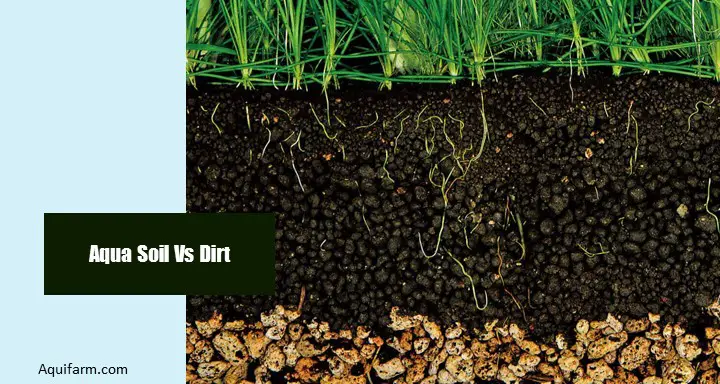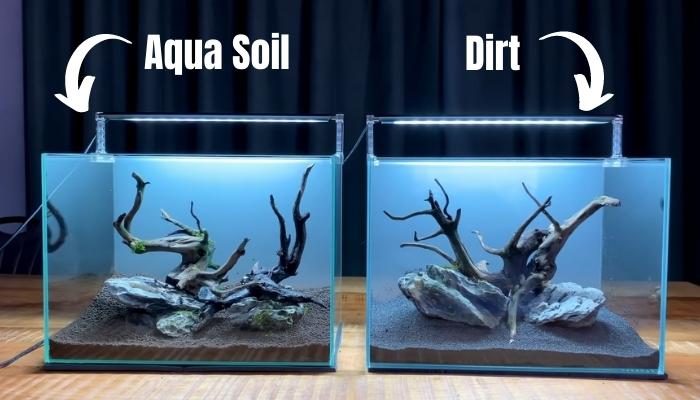
The health of your aquatic creatures and the aquarium plants depends on having the appropriate substrate. Although many people choose aqua soil or dirt for their aquascape. Your aquarium plants will thrive, and get the nourishment they need.
They will reproduce in your tank if you have a decent substrate.
So, aqua soil vs dirt?
The majority of aquatic plants grow well and attractively in aqua soil. Because of its robust nature, aqua soil is a substrate material. This must be used with certain methods. However, dirt is often less costly than commercial aqua soils and has significant concentrations of plant nutrients.
It requires certain methods to utilize these. Let’s learn more about these. So that you may utilize it more effectively and create a stunning aquascape.
Aqua Soil And Dirt: Quick Comparison
Aquarium dirt or aqua soil, which is made particularly for tanks, is pricey. This raises the issue of whether regular soil would work just as well. Which type of soil you choose to utilize will determine the answer.
Here we have some comparisons between aqua soil and dirt:
| Particulars | Aqua Soil | Dirt |
| Cost | Expensive | Less Expensive |
| Longevity | 1-3 years | 10-12 years |
| Nutrients | Highly rich nitrogen and ammonium | Nitrogen and organic substances |
| Aquarium water | Cloudy | Muddy |
Let’s get going!
Aqua Soil vs. Dirt: Detailed Comparison

In aquariums, plants get minerals from the soil in their natural environment. That is why many aquarists kept dirt in their aquariums from the very inception of the aquascaping hobby.
Here we have an aqua soil which may become handy for you: LANDEN Aqua Soil Substrate for Natural Planted Aquarium.
So, let’s find out the detailed comparison between aqua soil and dirt.
Cost
At first, the most common question that comes to our mind is the cost. This varies according to the quality of the soil.
Aqua Soil
Comparatively aqua soil is more expensive than dirt. Its price range starts from $10 to $15 per kilogram.
Dirt
Because they assure to be less expensive, dirt tanks appeal to a lot of fish keepers. This is unquestionably the case if you purchase dirt, which would be the least costly soil. Its price range starts from $5 to 10$ per kilogram
Most commercial aqua soils are more costly than dirt. However certain potting soils might be priced similarly.
Longevity
This is the thing that differentiates huge aqua soil from dirt.
Aqua Soil
For 2 – 3 years, you may utilize a substrate composed of aqua soil. However, the nutrients in aqua soil will eventually be lost. Therefore, it is best to supplement the substrate with nutrients using Multi Bottom.
You can replace the dirt on the surface of the substrate with fresh aqua soil to make up for the lack of nutrients. In order to encourage the establishment of new aquatic plants.
It is advised to remove as much of the old aqua soil as you can. And replace it with fresh aqua soil. Blue-green algae may grow in the substrate if the aqua soil granules fall apart.
And make it less permeable. If you have this issue, you should construct a new substrate.
Dirt
Dirted tanks have been known to persist for several years, sometimes even longer. While the majority of experts claim that commercial aqua soils only have a shelf life of 2-3 years.
Dirted aquariums have a longer lifetime in part because of the enormous quantity of nourishment. They can hold nourishment which takes a very long time for organisms to use up.
These very long-lasting tanks are most likely the outcome of a powerful deionization cycle. Instead of the substrate itself, it is attained in several dirty tanks over time.
Nutrients
Diverse nutrients are necessary for the healthy development of aquarium plants. Additionally, nutrients including nitrogen, phosphate, calcium, dolomite, potassium, and sulfur are needed by plants. They need a lot of these nutrients, which is why they are referred to as macronutrients.
Aqua Soil
The ability of aqua soil to encourage the development of aquatic plants is its best quality. The foundation material, a naturally black soil rich in organic compounds and nitrogen holds the key. The caveat is that not just any black dirt will do.
The foundation dirt used for aqua soil is a highly uncommon, rather sticky black soil. This is rich in chemicals originating from plants. It differs significantly from typical black volcanic debris soils.
The amount of nitrogen in the water has a significant impact on how quickly aquatic plants develop. Because of its exceptional nitrogen content. Aqua soil releases a significant quantity of ammonium (NH4) into the water.
It happens when it is placed in the aquarium. However, in environments where the pH level is greater than balanced (above 7.0). Salt is transformed into extremely poisonous ammonia (NH3).
Even into nitrite (NO2) inside the oxidation process. This is driven by nitrification which transforms ammonium into highly toxic nitrates. Ammonium is not harmful to aquatic and shrimp (NO3).
Dirt
Macro and micronutrients are contained in the dirt. These are often on par with or even greater than those in commercial aqua soils. The key factor influencing how many fishkeepers decide to purchase commercial aqua soils is these nutrients.
So why would someone purchase soil when they can just get the same minerals for less money?
Aqua soils are produced for commercial purposes. Hence their chemical makeup is predictable. You can be sure that any bag you purchase will provide a reliable experience.
Contrarily, the amount of nutrients in the dirt varies based on the kind and location of purchase.
Aquarium Water
This is one of the drawbacks of dirt. For this reason, many users choose aqua soil for their aquariums.
Aqua Soil
The granules that have been lightly baked make up aqua soil. Aquarium water with aqua soil substrate may become hazy. It happens when water is added if the container of aqua soil is left open.
The granules get overly dry, or the grains disintegrate into powders due to friction during shipment. When water is added to a planted aquarium for the first time and the water becomes foggy.
All of the cloudy water should be removed before progressively adding fresh water. Repeat the water transfer or pour new water while dumping the murky water. Make careful to only activate the filter once the water is crystal clear.
Dirt
The water column will mix with a dirt substrate to provide an extremely muddy appearance. This occurs when the container is incorrectly closed or when fishkeepers try to relocate the plants.
Plant removal will probably allow the soil to leak through the substrate cover and into the surrounding water. Because of this, it’s recommended to avoid making significant alterations to your aquascape.
Final Verdict
If you don’t have any problem with the muddy water then you can choose dirt undoubtedly. Otherwise, you have to choose aqua soil for your aquarium. As a result, it will cost you more.
FAQs
Is Aqua Soil Required?
No, you may maintain live aquatic plants in the tank without a dirt substrate. The majority of aquarium plants may be maintained without a dirt substrate. The plants may be planted in gravel or sand substrate.
What Materials Are In Aqua Soil?
Aqua soil which is excellent for producing aquatic plants, is produced from organic black soil as a foundation material.
Will Dirt Work In My Aquarium?
Unless you are certain of what’s in the soil, it is not advisable to use it for your tank.
Conclusion
We have come to an end now. So, by now you have much knowledge regarding aqua soil vs dirt.
Now reviewing the topics, choose the one which you need actually.
Have a great day!
Read More-
- Top 15 Freshwater Aquarium Plant Ideas for a Lush, Green Tank - November 9, 2024
- Top 13 Freshwater Aquarium Layout Ideas for a Beautifully Organized Tank - November 9, 2024
- 14 Stunning Rustic Freshwater Aquarium Ideas for a Tranquil Environment - November 9, 2024
